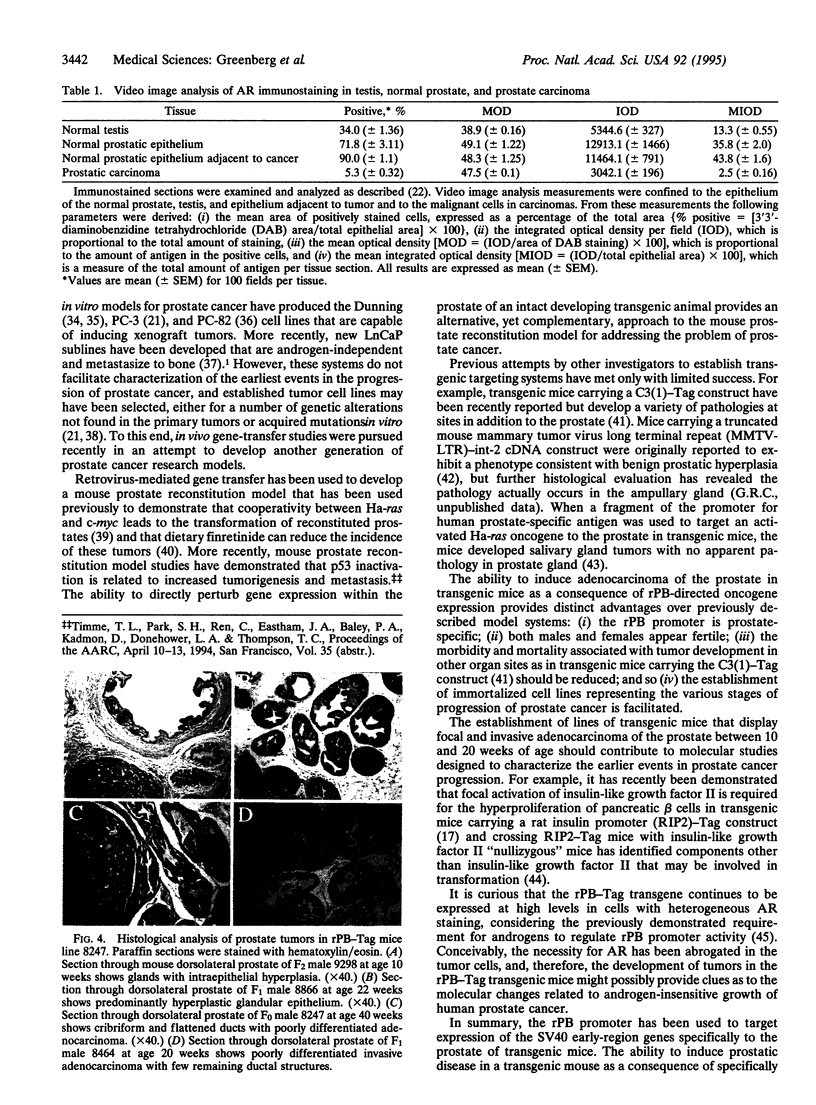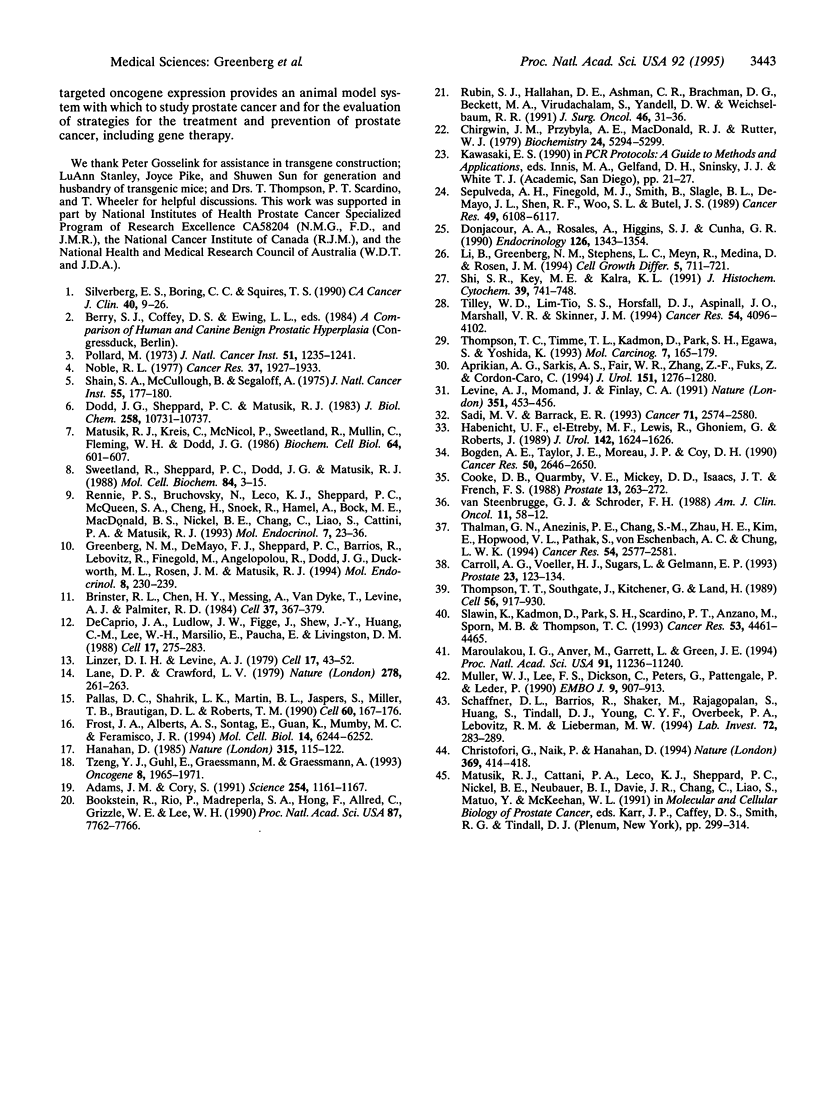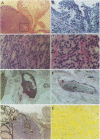Abstract
Progress toward understanding the biology of prostate cancer has been slow due to the few animal research models available to study the spectrum of this uniquely human disease. To develop an animal model for prostate cancer, several lines of transgenic mice were generated by using the prostate-specific rat probasin promoter to derive expression of the simian virus 40 large tumor antigen-coding region. Mice expressing high levels of the transgene display progressive forms of prostatic disease that histologically resemble human prostate cancer, ranging from mild intraepithelial hyperplasia to large multinodular malignant neoplasia. Prostate tumors have been detected specifically in the prostate as early as 10 weeks of age. Immunohistochemical analysis of tumor tissue has demonstrated that dorsolateral prostate-specific secretory proteins were confined to well-differentiated ductal epithelial cells adjacent to, or within, the poorly differentiated tumor mass. Prostate tumors in the mice also display elevated levels of nuclear p53 and a decreased heterogeneous pattern of androgen-receptor expression, as observed in advanced human prostate cancer. The establishment of breeding lines of transgenic mice that reproducibly develop prostate cancer provides an animal model system to study the molecular basis of transformation of normal prostatic cells and the factors influencing the progression to metastatic prostate cancer.
Full text
PDF




Images in this article
Selected References
These references are in PubMed. This may not be the complete list of references from this article.
- Adams J. M., Cory S. Transgenic models of tumor development. Science. 1991 Nov 22;254(5035):1161–1167. doi: 10.1126/science.1957168. [DOI] [PubMed] [Google Scholar]
- Aprikian A. G., Sarkis A. S., Fair W. R., Zhang Z. F., Fuks Z., Cordon-Cardo C. Immunohistochemical determination of p53 protein nuclear accumulation in prostatic adenocarcinoma. J Urol. 1994 May;151(5):1276–1280. doi: 10.1016/s0022-5347(17)35231-x. [DOI] [PubMed] [Google Scholar]
- Bogden A. E., Taylor J. E., Moreau J. P., Coy D. H. Treatment of R-3327 prostate tumors with a somatostatin analogue (somatuline) as adjuvant therapy following surgical castration. Cancer Res. 1990 May 1;50(9):2646–2650. [PubMed] [Google Scholar]
- Bookstein R., Rio P., Madreperla S. A., Hong F., Allred C., Grizzle W. E., Lee W. H. Promoter deletion and loss of retinoblastoma gene expression in human prostate carcinoma. Proc Natl Acad Sci U S A. 1990 Oct;87(19):7762–7766. doi: 10.1073/pnas.87.19.7762. [DOI] [PMC free article] [PubMed] [Google Scholar]
- Brinster R. L., Chen H. Y., Messing A., van Dyke T., Levine A. J., Palmiter R. D. Transgenic mice harboring SV40 T-antigen genes develop characteristic brain tumors. Cell. 1984 Jun;37(2):367–379. doi: 10.1016/0092-8674(84)90367-2. [DOI] [PMC free article] [PubMed] [Google Scholar]
- Carroll A. G., Voeller H. J., Sugars L., Gelmann E. P. p53 oncogene mutations in three human prostate cancer cell lines. Prostate. 1993;23(2):123–134. doi: 10.1002/pros.2990230206. [DOI] [PubMed] [Google Scholar]
- Chirgwin J. M., Przybyla A. E., MacDonald R. J., Rutter W. J. Isolation of biologically active ribonucleic acid from sources enriched in ribonuclease. Biochemistry. 1979 Nov 27;18(24):5294–5299. doi: 10.1021/bi00591a005. [DOI] [PubMed] [Google Scholar]
- Christofori G., Naik P., Hanahan D. A second signal supplied by insulin-like growth factor II in oncogene-induced tumorigenesis. Nature. 1994 Jun 2;369(6479):414–418. doi: 10.1038/369414a0. [DOI] [PubMed] [Google Scholar]
- Cooke D. B., Quarmby V. E., Mickey D. D., Isaacs J. T., French F. S. Oncogene expression in prostate cancer: Dunning R3327 rat dorsal prostatic adenocarcinoma system. Prostate. 1988;13(4):263–272. doi: 10.1002/pros.2990130402. [DOI] [PubMed] [Google Scholar]
- DeCaprio J. A., Ludlow J. W., Figge J., Shew J. Y., Huang C. M., Lee W. H., Marsilio E., Paucha E., Livingston D. M. SV40 large tumor antigen forms a specific complex with the product of the retinoblastoma susceptibility gene. Cell. 1988 Jul 15;54(2):275–283. doi: 10.1016/0092-8674(88)90559-4. [DOI] [PubMed] [Google Scholar]
- Dodd J. G., Sheppard P. C., Matusik R. J. Characterization and cloning of rat dorsal prostate mRNAs. Androgen regulation of two closely related abundant mRNAs. J Biol Chem. 1983 Sep 10;258(17):10731–10737. [PubMed] [Google Scholar]
- Donjacour A. A., Rosales A., Higgins S. J., Cunha G. R. Characterization of antibodies to androgen-dependent secretory proteins of the mouse dorsolateral prostate. Endocrinology. 1990 Mar;126(3):1343–1354. doi: 10.1210/endo-126-3-1343. [DOI] [PubMed] [Google Scholar]
- Frost J. A., Alberts A. S., Sontag E., Guan K., Mumby M. C., Feramisco J. R. Simian virus 40 small t antigen cooperates with mitogen-activated kinases to stimulate AP-1 activity. Mol Cell Biol. 1994 Sep;14(9):6244–6252. doi: 10.1128/mcb.14.9.6244. [DOI] [PMC free article] [PubMed] [Google Scholar]
- Greenberg N. M., DeMayo F. J., Sheppard P. C., Barrios R., Lebovitz R., Finegold M., Angelopoulou R., Dodd J. G., Duckworth M. L., Rosen J. M. The rat probasin gene promoter directs hormonally and developmentally regulated expression of a heterologous gene specifically to the prostate in transgenic mice. Mol Endocrinol. 1994 Feb;8(2):230–239. doi: 10.1210/mend.8.2.8170479. [DOI] [PubMed] [Google Scholar]
- Habenicht U. F., el Etreby M. F., Lewis R., Ghoniem G., Roberts J. Induction of metachromasia in experimentally induced hyperplastic/hypertrophic changes in the prostate of the cynomolgus monkey (Macaca fascicularis). J Urol. 1989 Dec;142(6):1624–1626. doi: 10.1016/s0022-5347(17)39181-4. [DOI] [PubMed] [Google Scholar]
- Hanahan D. Heritable formation of pancreatic beta-cell tumours in transgenic mice expressing recombinant insulin/simian virus 40 oncogenes. Nature. 1985 May 9;315(6015):115–122. doi: 10.1038/315115a0. [DOI] [PubMed] [Google Scholar]
- Lane D. P., Crawford L. V. T antigen is bound to a host protein in SV40-transformed cells. Nature. 1979 Mar 15;278(5701):261–263. doi: 10.1038/278261a0. [DOI] [PubMed] [Google Scholar]
- Levine A. J., Momand J., Finlay C. A. The p53 tumour suppressor gene. Nature. 1991 Jun 6;351(6326):453–456. doi: 10.1038/351453a0. [DOI] [PubMed] [Google Scholar]
- Li B., Greenberg N., Stephens L. C., Meyn R., Medina D., Rosen J. M. Preferential overexpression of a 172Arg-->Leu mutant p53 in the mammary gland of transgenic mice results in altered lobuloalveolar development. Cell Growth Differ. 1994 Jul;5(7):711–721. [PubMed] [Google Scholar]
- Linzer D. I., Levine A. J. Characterization of a 54K dalton cellular SV40 tumor antigen present in SV40-transformed cells and uninfected embryonal carcinoma cells. Cell. 1979 May;17(1):43–52. doi: 10.1016/0092-8674(79)90293-9. [DOI] [PubMed] [Google Scholar]
- Maroulakou I. G., Anver M., Garrett L., Green J. E. Prostate and mammary adenocarcinoma in transgenic mice carrying a rat C3(1) simian virus 40 large tumor antigen fusion gene. Proc Natl Acad Sci U S A. 1994 Nov 8;91(23):11236–11240. doi: 10.1073/pnas.91.23.11236. [DOI] [PMC free article] [PubMed] [Google Scholar]
- Matusik R. J., Kreis C., McNicol P., Sweetland R., Mullin C., Fleming W. H., Dodd J. G. Regulation of prostatic genes: role of androgens and zinc in gene expression. Biochem Cell Biol. 1986 Jun;64(6):601–607. doi: 10.1139/o86-083. [DOI] [PubMed] [Google Scholar]
- Muller W. J., Lee F. S., Dickson C., Peters G., Pattengale P., Leder P. The int-2 gene product acts as an epithelial growth factor in transgenic mice. EMBO J. 1990 Mar;9(3):907–913. doi: 10.1002/j.1460-2075.1990.tb08188.x. [DOI] [PMC free article] [PubMed] [Google Scholar]
- Noble R. L. The development of prostatic adenocarcinoma in Nb rats following prolonged sex hormone administration. Cancer Res. 1977 Jun;37(6):1929–1933. [PubMed] [Google Scholar]
- Pallas D. C., Shahrik L. K., Martin B. L., Jaspers S., Miller T. B., Brautigan D. L., Roberts T. M. Polyoma small and middle T antigens and SV40 small t antigen form stable complexes with protein phosphatase 2A. Cell. 1990 Jan 12;60(1):167–176. doi: 10.1016/0092-8674(90)90726-u. [DOI] [PubMed] [Google Scholar]
- Pollard M. Spontaneous prostate adenocarcinomas in aged germfree Wistar rats. J Natl Cancer Inst. 1973 Oct;51(4):1235–1241. doi: 10.1093/jnci/51.4.1235. [DOI] [PubMed] [Google Scholar]
- Rennie P. S., Bruchovsky N., Leco K. J., Sheppard P. C., McQueen S. A., Cheng H., Snoek R., Hamel A., Bock M. E., MacDonald B. S. Characterization of two cis-acting DNA elements involved in the androgen regulation of the probasin gene. Mol Endocrinol. 1993 Jan;7(1):23–36. doi: 10.1210/mend.7.1.8446105. [DOI] [PubMed] [Google Scholar]
- Rubin S. J., Hallahan D. E., Ashman C. R., Brachman D. G., Beckett M. A., Virudachalam S., Yandell D. W., Weichselbaum R. R. Two prostate carcinoma cell lines demonstrate abnormalities in tumor suppressor genes. J Surg Oncol. 1991 Jan;46(1):31–36. doi: 10.1002/jso.2930460108. [DOI] [PubMed] [Google Scholar]
- Sadi M. V., Barrack E. R. Image analysis of androgen receptor immunostaining in metastatic prostate cancer. Heterogeneity as a predictor of response to hormonal therapy. Cancer. 1993 Apr 15;71(8):2574–2580. doi: 10.1002/1097-0142(19930415)71:8<2574::aid-cncr2820710823>3.0.co;2-1. [DOI] [PubMed] [Google Scholar]
- Schaffner D. L., Barrios R., Shaker M. R., Rajagopalan S., Huang S. L., Tindall D. J., Young C. Y., Overbeek P. A., Lebovitz R. M., Lieberman M. W. Transgenic mice carrying a PSArasT24 hybrid gene develop salivary gland and gastrointestinal tract neoplasms. Lab Invest. 1995 Mar;72(3):283–290. [PubMed] [Google Scholar]
- Sepulveda A. R., Finegold M. J., Smith B., Slagle B. L., DeMayo J. L., Shen R. F., Woo S. L., Butel J. S. Development of a transgenic mouse system for the analysis of stages in liver carcinogenesis using tissue-specific expression of SV40 large T-antigen controlled by regulatory elements of the human alpha-1-antitrypsin gene. Cancer Res. 1989 Nov 1;49(21):6108–6117. [PubMed] [Google Scholar]
- Shain S. A., McCullough B., Segaloff A. Spontaneous adenocarcinomas of the ventral prostate of aged A X C rats. J Natl Cancer Inst. 1975 Jul;55(1):177–180. doi: 10.1093/jnci/55.1.177. [DOI] [PubMed] [Google Scholar]
- Shi S. R., Key M. E., Kalra K. L. Antigen retrieval in formalin-fixed, paraffin-embedded tissues: an enhancement method for immunohistochemical staining based on microwave oven heating of tissue sections. J Histochem Cytochem. 1991 Jun;39(6):741–748. doi: 10.1177/39.6.1709656. [DOI] [PubMed] [Google Scholar]
- Silverberg E., Boring C. C., Squires T. S. Cancer statistics, 1990. CA Cancer J Clin. 1990 Jan-Feb;40(1):9–26. [PubMed] [Google Scholar]
- Slawin K., Kadmon D., Park S. H., Scardino P. T., Anzano M., Sporn M. B., Thompson T. C. Dietary fenretinide, a synthetic retinoid, decreases the tumor incidence and the tumor mass of ras+myc-induced carcinomas in the mouse prostate reconstitution model system. Cancer Res. 1993 Oct 1;53(19):4461–4465. [PubMed] [Google Scholar]
- Sweetland R., Sheppard P. C., Dodd J. G., Matusik R. J. Post-castration rebound of an androgen regulated prostatic gene. Mol Cell Biochem. 1988 Nov;84(1):3–15. doi: 10.1007/BF00235188. [DOI] [PubMed] [Google Scholar]
- Thalmann G. N., Anezinis P. E., Chang S. M., Zhau H. E., Kim E. E., Hopwood V. L., Pathak S., von Eschenbach A. C., Chung L. W. Androgen-independent cancer progression and bone metastasis in the LNCaP model of human prostate cancer. Cancer Res. 1994 May 15;54(10):2577–2581. [PubMed] [Google Scholar]
- Thompson T. C., Southgate J., Kitchener G., Land H. Multistage carcinogenesis induced by ras and myc oncogenes in a reconstituted organ. Cell. 1989 Mar 24;56(6):917–930. doi: 10.1016/0092-8674(89)90625-9. [DOI] [PubMed] [Google Scholar]
- Thompson T. C., Timme T. L., Kadmon D., Park S. H., Egawa S., Yoshida K. Genetic predisposition and mesenchymal-epithelial interactions in ras+myc-induced carcinogenesis in reconstituted mouse prostate. Mol Carcinog. 1993;7(3):165–179. doi: 10.1002/mc.2940070307. [DOI] [PubMed] [Google Scholar]
- Tilley W. D., Lim-Tio S. S., Horsfall D. J., Aspinall J. O., Marshall V. R., Skinner J. M. Detection of discrete androgen receptor epitopes in prostate cancer by immunostaining: measurement by color video image analysis. Cancer Res. 1994 Aug 1;54(15):4096–4102. [PubMed] [Google Scholar]
- Tzeng Y. J., Guhl E., Graessmann M., Graessmann A. Breast cancer formation in transgenic animals induced by the whey acidic protein SV40 T antigen (WAP-SV-T) hybrid gene. Oncogene. 1993 Jul;8(7):1965–1971. [PubMed] [Google Scholar]
- van Steenbrugge G. J., Schröder F. H. Androgen-dependent human prostate cancer in nude mice. The PC-82 tumor model. Am J Clin Oncol. 1988;11 (Suppl 2):S8–12. doi: 10.1097/00000421-198801102-00003. [DOI] [PubMed] [Google Scholar]






